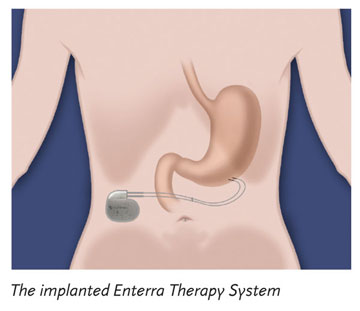Gastric Surgery
What we do
Gastric surgery refers to stomach surgery. Stomach diseases that can be treated with surgery include stomach cancers, some stomach ulcers and blockages of the stomach. In addition, symptoms related to gastroparesis (poor functioning of the stomach, usually due to diabetes) can be treated with a surgically place neurostimulator.
Our qualifications
At Henry Ford, our surgeons are among the few in the state who can perform laparoscopic gastric resections, a procedure used to treat people with early stage stomach cancer. The gastric surgery practice is one of the busiest in the state with patients from all over the Midwest coming to Henry Ford for complex gastric surgeries.

Surgery for patients with gastroparesis
Patients who have severe gastroparesis from diabetes or unknown causes (idiopathic), can find help with a new medical device at Henry Ford Hospital. Henry Ford Hospital surgeons have the largest experience in Michigan with this device.
Gastroparesis is when food moves through the stomach more slowly than normal. For some people, severe, chronic nausea and vomiting that traditional drugs can't control is the result.
Patients with gastroparesis often have difficulty being able to eat and keep food down. Sometimes, the patients are forced to have some sort of feeding tube.
By using Enterra Therapy, patients are finding relief. Enterra therapy is when a small battery-powered device (like a pacemaker) is placed in the patient near the stomach. By putting out small, mild electrical pulses, the nerves in the stomach are stimulated and the the muscles are smoothed out. It has been shown to reduce the number of vomiting episodes and feeling of nausea.
The system consists of:
- A small, battery-powered neurostimulator (about the size of a pocket watch; 2.4 inches long, 2.2 inches high, 0.4 inches thick), implanted beneath the skin in the lower abdominal region.
- Two leads (insulated wires), implanted in the muscle wall of the stomach that are connected to the neurostimulator.
- A handheld, external clinician programmer, used by the doctor to customize the pulses and the therapy.
Implanting an Enterra Therapy System typically takes from 1 to 2 hours under general anesthesia.
Outcomes
Three-quarters of patients who received this therapy responded well to the device. Their symptoms improved. Patients reported that their overall health and quality of life improved after the device was implanted. Considering how intractable and difficult the patients' lives were, the response to the Enterra device is encouraging.
.svg?iar=0&hash=F6049510E33E4E6D8196C26CCC0A64A4)

/hfh-logo-main--white.svg?iar=0&hash=ED491CBFADFB7670FAE94559C98D7798)